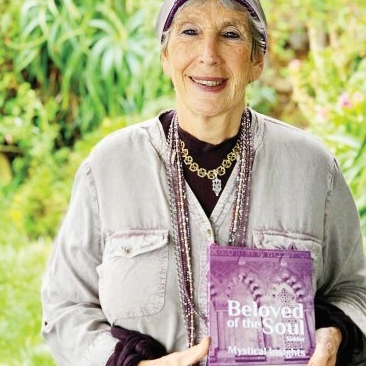
SA

New siddur feast for the eyes and food for the soul
MOIRA SCHNEIDER
Evian, an Observant teacher of Jewish mysticism and a ceramicist, and Nivison, a dancer, clothing designer, and yoga and meditation practitioner, clicked immediately. “Balu wanted to connect to Judaism, and couldn’t find a way in,” Evian recalls of the time.
“At one point in our relationship, she asked me to teach her how to pray. So I bought her a siddur, and marked the morning prayers that transported one … and that became very meaningful for her.
“It was also very meaningful for me to see what the essential prayers are, because when you open up a siddur with 957 pages – if you have not learned about it – it’s hard to know where to begin.”
Thus, the seed was planted for the pair’s four-year journey to produce the recently published Beloved of the Soul. “Balu was the one who suggested it to enable people like her to access prayer as a daily ritual,” Evian recalls.
Nivison also suggested the title, a translation of Yedid Nefesh, a pre-Sabbath prayer expressing the soul’s yearning and desire to be close to G-d, reflecting her own journey.
“I had been searching for many years in different permutations for some kind of meaning and a way that Judaism could be aligned with my life as an artist and a dancer,” says Nivison. “Sara ended up teaching me how to pray, what the prayers meant, and what the purpose of prayer was. I had no idea.”
Together they started Beloved of the Soul workshops combining Nivison’s dance, movement, and yoga with Evian’s Torah wisdom, using soulful Jewish music. “I wanted to bring Judaism alive, and I wanted a place for women to feel that they could have an experiential Judaism. That is, as opposed to having to stand upstairs or on the sides behind a mechitzah (partition separating men and women in synagogue) and kind of bob up and down and have no idea where their place was,” Nivison says.
Support came from a rather unexpected source in that “quite a few” rebbetzins (rabbis’ wives) started attending the workshops. “We had a whole following of very Orthodox women who absolutely love to dance and move and find a way to express their souls in a Jewish way,” she says.
“I thought we were going to be appealing to the waifs and strays, but it’s not like that at all!
“Eventually, I said to Sara that it would be such a tragedy if her wisdom and way of teaching and interpretation didn’t get out into the world, especially for Jews who were alienated or had no idea about the treasures of Judaism.”
Evian, the author, has worked in conjunction with Orthodox rabbis all the way, and has incorporated many of the teachings of Rav Daniel Kohn of Israel. “His teaching of Torah was so exceptional. I could never have embarked on this book without it,” she stresses.
The siddur differs from others in that it comprises a selection of morning prayers “so that one doesn’t become overwhelmed”. The first part consists of mystical insights into prayer and connection, including sections on praying with intention, movement, music, song, and meditation before prayer “so that prayer becomes a full-bodied experience”.
It reads both ways: the first half reads as an English book from left to right, and the second half – the daily prayers – from right to left. In the first half, Evian relates that each person has five levels to the soul, and explains what these levels are – a first for any siddur, according to Nivison.
The “very few” select prayers in the siddur have been arranged according to those levels. “One starts in the physical realm nefesh, (the morning blessings) and one moves upward to the emotional realm (ruach), songs of praise such as ashrei, and then upward into the intellectual realm (neshama) of the Sh’ma, where there’s a sense of unification,” Evian says.
“Then one goes into the fourth level of chaya (the Amidah), the level of our soul which is transcendent, our place of insight outside of the body. It ends in the level of yechida, which is oneness with Hashem.
“The prayers are broken into these levels so that you understand as you pray that you are moving on a journey – the ladder of prayer.”
The prayers are in Hebrew, with transliterations and translations. “We’ve tried to make the translations accessible to our day and age without losing any of the authenticity,” says Evian, crediting Rabbi David Nossel of Johannesburg and many “mainly” Chassidic sources.
The siddur is “definitely not” specifically for women, rather it is intended to make prayer undaunting, meaningful, and accessible. “It’s not about going through everything, it’s about feeling that you are connecting while you are doing it, even if you are saying less,” she says.
“Even if you sit with the siddur open on one page with an image of a shul in Poland or Prague (the pair travelled to these once vibrant Jewish centres) or an image capturing G-d’s natural glory, and you read the words of the psalms that are written on it.” The images form a backdrop to many of the prayers and psalms.
In the words of the preface, the prayer book is as much food for the eyes as it is food for the soul.
While the siddur is “very abridged”, being a selection of essential prayers that need to be said in the morning, Evian says that as far as she is aware, it is the only one to have been produced in this country.
- Beloved of the Soul is available in Jewish bookshops in Johannesburg, and the South African Jewish Museum shop in Cape Town. It will be launched in Johannesburg at the Chief Rabbi Cyril Harris Centre and at the South African Jewish Museum in Cape Town in September.




